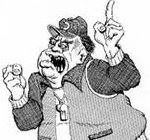We don’t do as much haying as Ardis did. Our land is hilly and rocky – good for pasture not hayfields. Our neighbor comes up and helps us cut about eight acres and make old-fashioned square bales. Some days, though, I wish Ardis was here to throw them on the wagon.
I wish my dad was here too. After high school, and the Battle of the Bulge, he settled into farming, worked in a gas station, then finally retired as a postal clerk. But he never lost his taste for farming.
After retirement he cut and baled hay off the local dentist’s land in exchange for any dental work he needed. Mom says that when Dad was young all the farmers around wanted him to do their planting because he could run the straightest furrow in the county. It showed up in his haying, too. Every stage can make the next one harder or easier. First is cutting, making sure that you hit each swath square, so there aren’t any curves at the edges of the field. Then raking nice straight rows makes them easy to bale. Dad always liked to rake two rows together, not quite on top of each other, so they looked like an “M” of hay from the end of the windrow. Then came the baler to gather, compress, knot the twine and throw the bales into the hay wagon.
He was careful, conscientious, and kept the equipment well maintained. He knew every field like the back of his hand and would always stop if he saw a doe because that meant there was a fawn bedded in the grass, too. He would carefully walk back and forth until he located the fawn because he ran over one with the mower one time and that was enough for him.
After we bought this farm, Dad helped me figure out what to do with it - how to renovate the pastures, when to disk and when to cultivate, the best places for the split-rail fences. I called him often to get his advice and wished he lived across the road.
Once when Mom and Dad were visiting, we built a pig feeder with my kids, Conor and Charlotte. Three generations making a tall upright chute that spilled grain into two troughs on either side. When we finished, Dad said, “Well, if you get out of pigs, you can always use this as a giant bird feeder.” And that’s just what it looked like.
We would always visit Mom and Dad at the end of May because he and Charlotte had the same birthday. One time we hit it right for haying season and he asked if I wanted to help. Boy, did I. He cut one field with a brand-new John Deer and a haybine that crushed the stems a little to speed up drying. I raked the field he had already cut with an orange Allis-Chalmers we called “Alice”, of course. I don’t think I had many happier times than those days when I was in a sunny field on one tractor looking at him on another one.
He was quiet and kept most things inside but I could tell he was enjoying himself, too. As we sat in the truck having our lunch, we looked out at tractors that didn’t have to be rested and a baler that even threw the bales into the wagon for us. He said, “When I was a kid, I remember when we got our first hay loader. Until then, we always pitched loose hay on the wagons with forks, but that hay loader just pulled it all up and dumped it on the wagon in a nice pile. All we had to do was pitch it off into the barn. At the time we thought it doesn’t get any better than this.”
Dad’s gone now, but as we sat in the sweet smell of newly mown hay that day, I was thinking, “It doesn’t get any better than this.”
Friday, May 11, 2007
Subscribe to:
Post Comments (Atom)







No comments:
Post a Comment